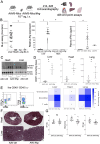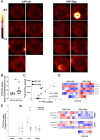This is a preprint.
Interferon gamma signaling drives cardiac metabolic rewiring
- PMID: 40950099
- PMCID: PMC12424622
- DOI: 10.1101/2025.08.31.673391
Interferon gamma signaling drives cardiac metabolic rewiring
Abstract
Background: IFN-gamma (IFN-γ) signaling influences myocardial inflammation and fibrosis across a wide range of conditions, including ischemic and non-ischemic heart failure (HF). However, the direct effects of IFN-γ on cardiomyocytes remain poorly understood. Here, we developed a novel in vivo model to investigate how IFN-γ impacts myocardial metabolism and function.
Methods: Male C57BL/6J mice were injected intravenously with hepatotropic adeno-associated virus (AAV2/8) carrying Ifng and nLuc reporter under the albumin promoter (AAV-Ifng) or empty vector control virus (AAV-ctrl). Cardiac alterations were monitored on day 28 through flow cytometry, bulk RNA sequencing, targeted metabolomics, isolated mitochondrial activity, echocardiography, and in vivo imaging using [18F]fluordeoxyglucose ([18F]FDG) and [18F]fluoro-6-thia-heptadecanoic acid. Additionally, mice lacking IFN-γ receptor expression in cardiomyocytes (Myh6 Cre Ifngr1 fl/fl) were used to further dissect the cell-intrinsic roles of IFN-γ signaling in cardiomyocyte metabolic reprograming.
Results: After confirming liver-specific viral transfection and elevated serum IFN-γ production at physiological levels, we observed cardiac metabolic adaptation and rewiring in animals treated with AAV-Ifng compared to control animals. Myocardial bulk RNA sequencing and gene set enrichment analysis identified an IFN-γ response signature accompanied by marked down-regulations of oxidative phosphorylation and fatty acid oxidation pathways. Functional assessment of isolated cardiac mitochondria showed decreased oxygen consumption, and targeted metabolomics confirmed metabolic shifts toward glycolysis in mice overexpressing IFN-γ. In vivo imaging confirmed increased cardiac glucose uptake following AAV-Ifng treatment. Notably, these metabolic alterations were abrogated in mice with cardiomyocyte-specific deletion of IFN-γ receptors (IFNGR).
Conclusions: Systemic IFN-γ induces pronounced metabolic reprogramming in the heart, characterized by increased glucose uptake and reduced oxidative phosphorylation, via direct signaling through cardiomyocyte IFNGR. These alterations mirror those observed in aging and some forms of HF, thereby highlighting that, beyond classical inflammation, this cytokine regulates cardiac metabolism.
Keywords: T cells; cardiac metabolism; cardiomyocytes; interferon gamma; mitochondria.
Figures






References
-
- Alter C, Henseler AS, Owenier C, Hesse J, Ding Z, Lautwein T, Bahr J, Hayat S, Kramann R, Kostenis E, et al. IL-6 in the infarcted heart is preferentially formed by fibroblasts and modulated by purinergic signaling. J Clin Invest. 2023;133. doi: 10.1172/jci163799 - DOI
Publication types
Grants and funding
LinkOut - more resources
Full Text Sources
Research Materials
Miscellaneous
